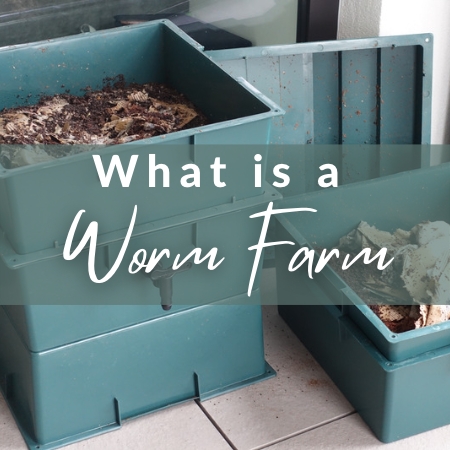A worm farm is a container filled with worms that can be fed kitchen scraps. This farm produces worm castings that can be added to your garden as a fertilizer. The worm castings are full of microbial life which can give your garden a boost helping plants to grow strong.
Benefits of Keeping Worms.
Worm farms produce worm castings which are mixed with compost and added to your garden. Worm tea can also be produced by bubbling castings in a bubbler. For children, it is a great way of learning about reducing our need to take food off-site for disposal and to teach them about worm biology.
Where to start?
My first worm farm was a simple 30liter container and 1kg of worms (ordered online) kept in my garage. I shredded some paper and card, soaked them in water, added some compost and the worms, and left them for a week for the worms to settle.
Locating the farm
I locate my farm in my single brick garage. I have a heated seed matt underneath the farm on a timer should it get cold. I also have a led night light (borrowed from my kid’s room) which comes on when it gets dark. The seed matt and the light are not necessities but were cheap additions to enable the worms to process during the colder temperatures and to give me an added sense of security that the worms won’t escape. They may attempt to escape when first introduced but as soon as they settle in and the conditions are good escape risk is minimized. You could have a farm under your sink, in your basement, or in the corner of a room.
Feeding the worms
Save up your food scraps in bags in the freezer. This also softens up the scraps when defrosted, which helps break them down). Worms feed on decomposing food and not when it is fresh. Every time I feed the bin I add a layer of shredded card underneath the food to soak up any leachate that may come off the food and provides some oxygen pockets to keep the bin aerated. This has the benefit of providing a feeding buffer of card for the worms should I ever leave the bin for longer than a week. I have left the bin on occasion for up to a month with no problems. I will then cover the scraps with a layer of castings and cover with a piece of cardboard.
I check the bin once a week to see how the scraps are being consumed and if they are getting low I feed the opposite side of the bin. I am also checking for any potential problems.
Tips for Success
Use common sense when feeding the worms. Too many onions or citrus may affect the farm so I make zip-lock bags with a mixture of foods so there is not an excess of any one item. I stick to fruit and vegetables to keep it simple although it is possible to feed cooked food like rice for example.
Cover the farm with a layer of hessian or a piece of cardboard to help with moisture control and fly control.
When inspecting the farm it should be wet but not soaking. If it dries out add some rainwater or tap water (left out for 24hrs for the chlorine to evaporate) using an old repurposed spay bottle (well cleaned and rinsed of course!)
Troubleshooting problems
I’ve had worms escape, mites, pot worms, fruit flies, drying out, too wet, too cold, too dry and the list goes on. There are some great Facebook groups and websites out there with advice on all these topics. Inspecting your farm on a regular basis ensures these problems are dealt with before they get too bad. Investing a small amount in a small system like this is great for learning, if it goes wrong you have only a small amount invested in it. Do not let potential problems put you off from starting a worm farm. All your problems have been seen and experienced before and there is a great community out there more than happy to talk worms and give you the advice you need.
Harvesting
Worm farms produce worms and worm castings. The worms will self-regulate their breeding based on the environment and size of the living space. For a farm this size castings and worms can be separated on a table with a bright light. The worms will burrow down and a thin layer of castings is removed. Repeat this every 5 minutes until finished. I have also used a fine soil sifter to harvest castings.
The worms can be used to refill a new system or what I would advise doing is half them and start 2 small bins. This gives them more room to breed up and once the 2 systems are mature enough doubles your capacity to produce castings and deal with double the food waste.
The worms may be used for fishing or some released into an outdoor compost pile.
The castings can be mixed with compost and added to your garden in a potting mix or to your beds.
Conclusion
Once you master this size of farm you will have the experience and confidence to invest in a bigger farm using a bigger tub, a wheelie bin, or even an IBC tote system. For keeping worms outdoors you can have an in-ground worm farm or use windrows to scale up which may take a bigger time investment.
From experience, keeping worms is a great hobby, doesn’t require a big-time investment, and also can contribute to avoiding sending waste to landfills. Harvesting worms and castings from my tiny bin was a great feeling knowing I had produced a quality product from food waste and card waste which I was able to apply in my garden.
There are many complicated guides and it is all too very easy to be stuck with analysis paralysis. My advice would be to buy a cheap 30-liter storage box, add some soaked cardboard, some compost and buy a small number of worms online. With “skin in the game” and responsibility for your worms you’ll learn fast and soon master any problems that may arise and start to reap the benefits of keeping these magnificent little creatures.





